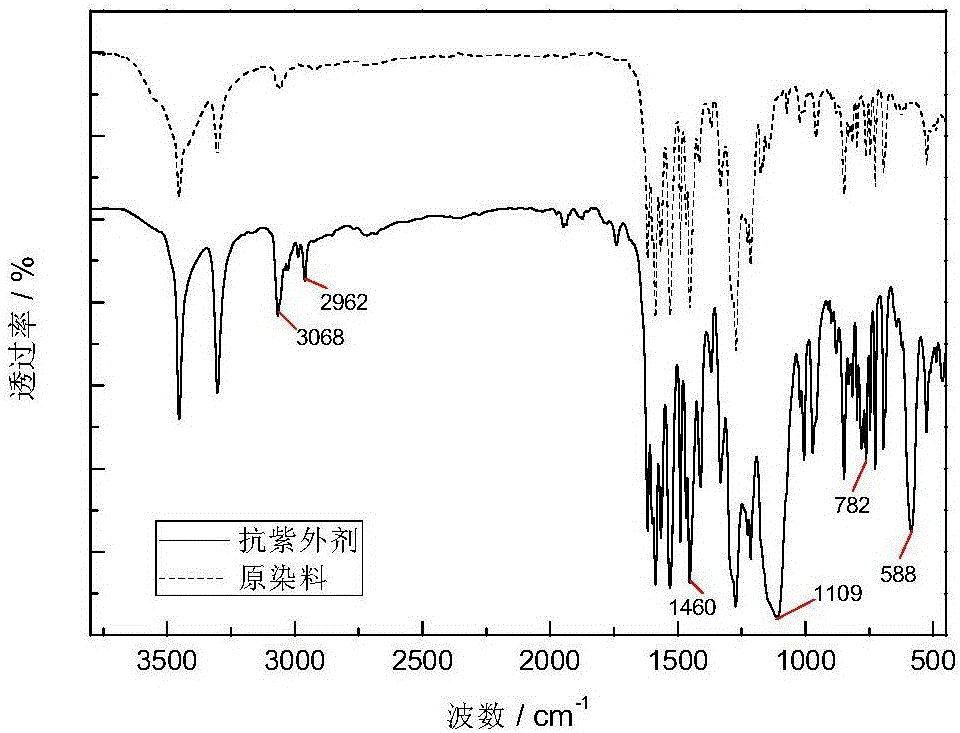Treatment method of ultraviolet-resistant aromatic high-performance fiber
A technology of high-performance fibers and processing methods, which is applied in the direction of fiber processing, light-resistant fibers, fiber types, etc., can solve problems such as failure to meet the use requirements, decrease in initial strength of fibers, and blockage of spinneret holes, etc., to achieve long-lasting anti-ultraviolet function, The effect of improving the strong retention rate and widening the application range
- Summary
- Abstract
- Description
- Claims
- Application Information
AI Technical Summary
Problems solved by technology
Method used
Image
Examples
Embodiment 1
[0044] Mix 0.3 parts of octavinyl silsesquioxane, 0.3 parts of octapropenyl silsesquioxane, and 0.8 parts of disperse red 60 dye, which are ground into powders with a particle size of 0.5 to 1 μm, and mix evenly. Add 60 parts of anhydrous aluminum chloride to 60 parts of carbon disulfide and 60 parts of carbon tetrachloride and stir until fully dissolved, then heat up to the boiling point of the mixed solvent, keep warm and reflux for 24 hours; after stopping heating, cool the mixed solution to 0 ℃, then add 0.4 parts of triethylamine and 0.3 parts of diethylamine mixture and stir evenly, filter under reduced pressure, remove insoluble catalyst, and distill the filtrate under reduced pressure to remove the solvent to obtain the crude product of anti-ultraviolet treatment agent; add the crude product to 250 parts In dichloromethane, reflux extraction in a Soxhlet extractor for 18 hours, then filter under reduced pressure to remove the undissolved original dye, and finally distil...
Embodiment 2
[0046] Mix 0.6 parts of octapropenyl silsesquioxane and 1.2 parts of disperse red 60 dye, which are ground into powders with a particle size of 0.5-1 μm, and mix evenly. Add 60 parts of benzene together with 0.15 parts of anhydrous ferric chloride under nitrogen atmosphere. Stir in medium until fully dissolved, then raise the temperature to the boiling point of the mixed solvent, keep warm and reflux for 30 hours; after stopping heating, cool the mixed solution to 2°C with ice water, then add 1.9 parts of diethylamine and stir evenly, filter under reduced pressure, remove Insoluble catalyst, the filtrate decompression distillation removes the solvent to obtain the anti-ultraviolet treatment agent crude product; the crude product is added in 65 parts of methylene chloride and 65 parts of toluene, reflux extraction in a Soxhlet extractor for 30 hours, and then filtered under reduced pressure, The undissolved original dye is removed, and finally the filtrate is distilled under red...
Embodiment 3
[0048] Mix 0.6 parts of octanyl silsesquioxane and 3.2 parts of disperse yellow 42 dyes that are ground into powders with a particle size of 0.5 to 1 μm, and mix them evenly. Under nitrogen atmosphere, together with 0.22 parts of anhydrous ferric chloride and 0.23 parts of Add 300 parts of carbon disulfide and 200 parts of benzene together with magnesium chloride and stir until fully dissolved, then raise the temperature to the boiling point of the mixed solvent, keep warm and reflux for 18 hours; after stopping heating, cool the mixed solution to 4°C with ice water, and then add 1.5 parts of diethyl Amine and 1.5 parts of dichloromethane mixture were stirred evenly, filtered under reduced pressure to remove insoluble catalyst, and the filtrate was distilled under reduced pressure to remove the solvent to obtain the crude product of anti-ultraviolet treatment agent; the crude product was added to 450 parts of dichloromethane and 340 parts of trichloro In methane, reflux extract...
PUM
 Login to View More
Login to View More Abstract
Description
Claims
Application Information
 Login to View More
Login to View More - R&D
- Intellectual Property
- Life Sciences
- Materials
- Tech Scout
- Unparalleled Data Quality
- Higher Quality Content
- 60% Fewer Hallucinations
Browse by: Latest US Patents, China's latest patents, Technical Efficacy Thesaurus, Application Domain, Technology Topic, Popular Technical Reports.
© 2025 PatSnap. All rights reserved.Legal|Privacy policy|Modern Slavery Act Transparency Statement|Sitemap|About US| Contact US: help@patsnap.com



